Ventilated floor: Vital Home Health 2025
Understanding the Essential Role of a Ventilated Floor
Do you notice a persistent musty smell in your home? Are you finding visible mould patches, or worried about damp impacting your family’s health? Often, the culprit lies beneath your feet: the subfloor, the unseen space between the ground and your home’s foundation. This is where a ventilated floor becomes essential.
For health-conscious homeowners in Sydney, understanding your ventilated floor is key to a dry, healthy home. Here’s why it’s so important:
- Prevents Moisture Buildup: A ventilated floor circulates air, stopping dampness from collecting in the subfloor.
- Combats Mould & Rot: It keeps timber framing and flooring dry, preventing mould, fungal growth, and structural rot.
- Improves Air Quality: By removing moist, stagnant air, it gets rid of musty smells and reduces harmful gases like radon and VOCs from entering your living space.
- Protects Your Home: It safeguards your property from costly damage and helps ensure a safe, comfortable environment.
Especially in Sydney’s humid climate, moisture from the ground can easily evaporate and become trapped in your subfloor. This creates a perfect breeding ground for mould, attracts pests, and can significantly impact indoor air quality, leading to allergies, asthma, and other respiratory issues. Addressing this problem at its root is crucial for your family’s health and your home’s structural integrity.
I’m Scott Lambert, founder of Dr. Damp and an expert in residential moisture control for over 20 years. I’ve specialized in ensuring homes have proper ventilated floor systems, helping Australians protect their properties from damp-related damage.
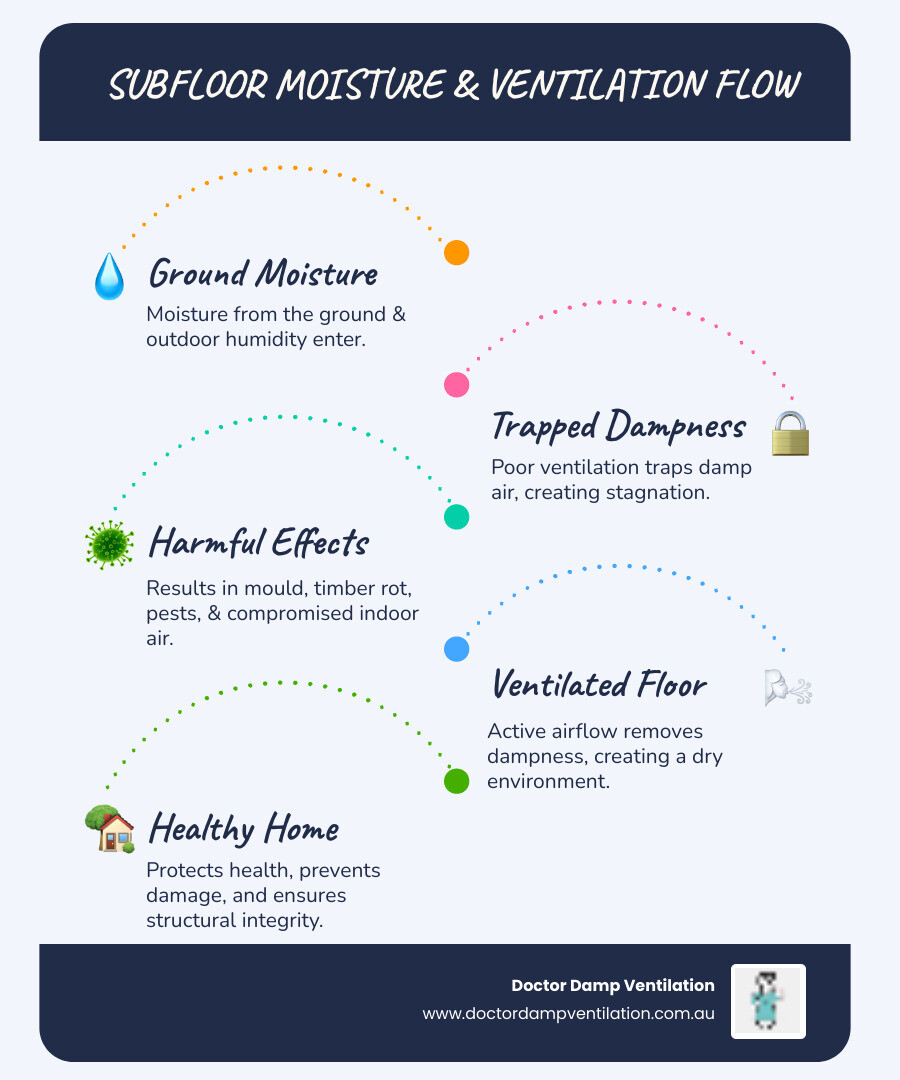
Essential ventilated floor terms:
The Unseen Threat: Why Your Subfloor Needs to Breathe
Think of your subfloor as your home’s hidden respiratory system. When this space can’t breathe properly, your entire house starts to suffer. Without adequate airflow beneath your floors, this forgotten area becomes a perfect storm for problems that can seriously impact both your family’s wellbeing and your home’s structure.
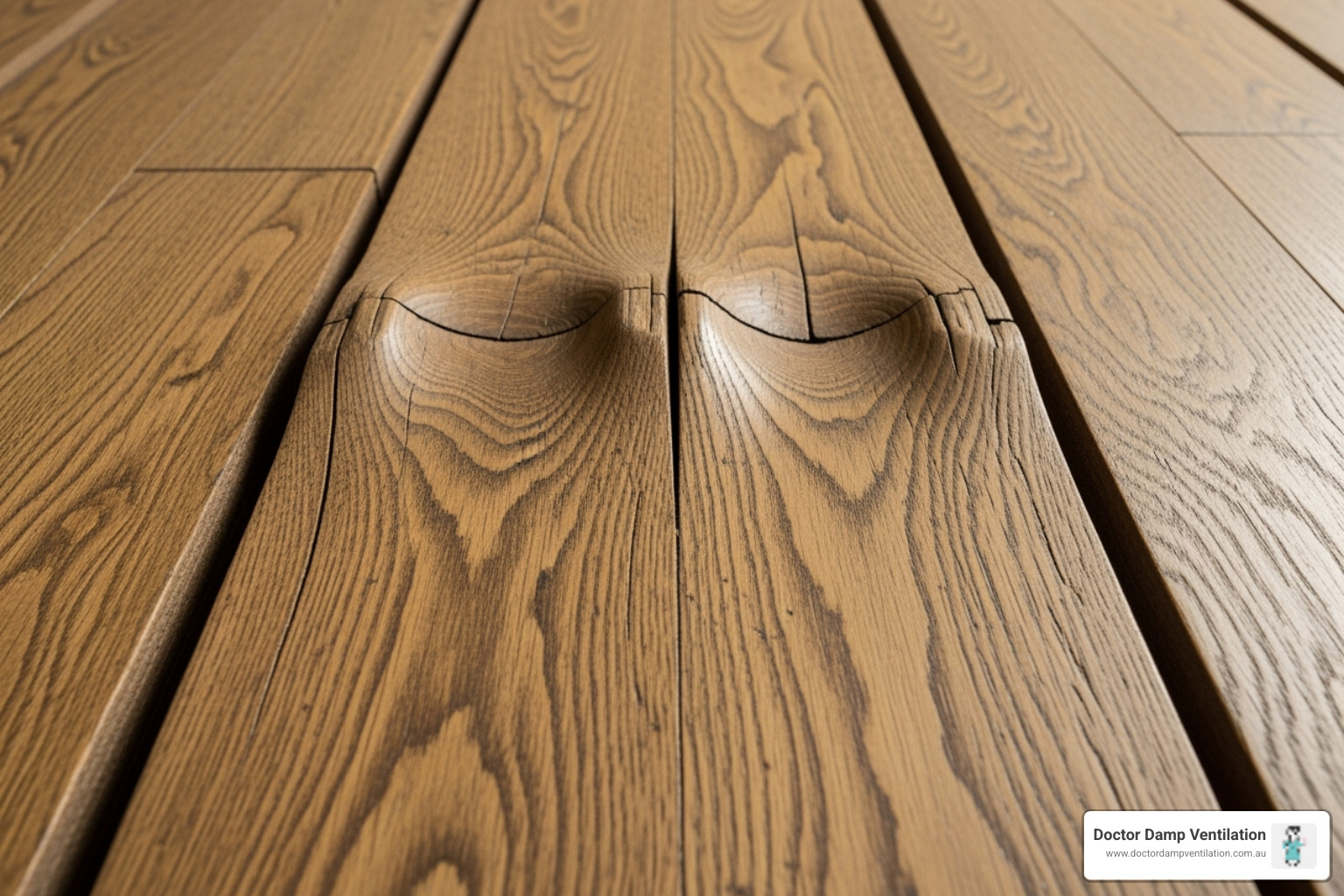
We’ve walked into countless homes across Sydney – from heritage properties in Paddington to modern builds in Maroubra – and been hit by that unmistakable musty smell. It’s not just unpleasant; it’s your home crying out for help. This odour signals moisture buildup beneath your floors, creating the perfect breeding ground for condensation, mould growth, and eventually timber rot.
The problems don’t stop there. Damp conditions attract unwanted guests, particularly termites, who love nothing more than softened, moisture-damaged timber. These destructive pests, combined with rotting wood, can cause serious structural damage that shows up as warped floorboards, creaky surfaces, and in worst cases, compromised foundations.
But here’s what really concerns us: the mould spores and other nasties floating up from a poorly ventilated subfloor don’t stay down there. They make their way into your living spaces, triggering allergies, asthma, and other respiratory issues for your family. Your safe haven shouldn’t make you sick. If mould has already taken hold, our comprehensive Mould Removal services can help you reclaim your healthy home environment.
Common Signs of Inadequate Ventilation
Spotting the warning signs early can save you thousands in repairs and protect your family’s health. We regularly help homeowners throughout the Eastern Suburbs, from Coogee to Randwick, identify these telltale symptoms:
Persistent musty smells are usually your first clue – that earthy, damp odour that gets stronger after rain or during humid weather. Damp patches on walls, especially near floor level, often point to moisture rising from below. You might notice peeling wallpaper or paint as moisture works its way up through your walls.
Your floors themselves tell a story too. Warped or creaky floorboards happen when timber absorbs moisture from underneath, causing the wood to swell and buckle. If you can peek into your subfloor space, visible mould on timber joists is a dead giveaway that ventilation isn’t doing its job.
Even your daily comfort suffers. High indoor humidity that persists despite air conditioning, and persistent condensation on windows – especially common in areas like Randwick during winter mornings – often trace back to moisture evaporating from poorly ventilated subfloors.
The Link Between Moisture and Structural Damage
Your home’s timber joists and bearers are tough, but they’re not invincible against constant dampness. When moisture gets trapped beneath your ventilated floor system, these crucial support beams become vulnerable to fungal decay.
Wet rot loves timber with moisture content above 20%, turning once-solid beams into soft, crumbly wood. Dry rot is even nastier – it spreads rapidly and can devastate timber structures throughout your home. Both types spell trouble for your foundations and lead to expensive, extensive repairs.
The moisture also rolls out the red carpet for termites, who can cause immense damage before you even know they’re there. These issues weaken your home’s structural integrity and threaten your biggest investment.
Many homeowners mistake these problems for rising damp, but often the real culprit is inadequate subfloor ventilation. The good news? Fixing ventilation is usually more cost-effective and successful than traditional damp treatments. Learn more about how we diagnose and treat Rising Damp to understand the difference.
How Subfloor Ventilation Works to Protect Your Home
Understanding the problem is the first step; the next is knowing how to fix it! Imagine your home taking a deep, healthy breath. That’s exactly what a properly designed ventilated floor system does. It works tirelessly, even when you’re not thinking about it, to keep your home dry, fresh, and healthy from the ground up.
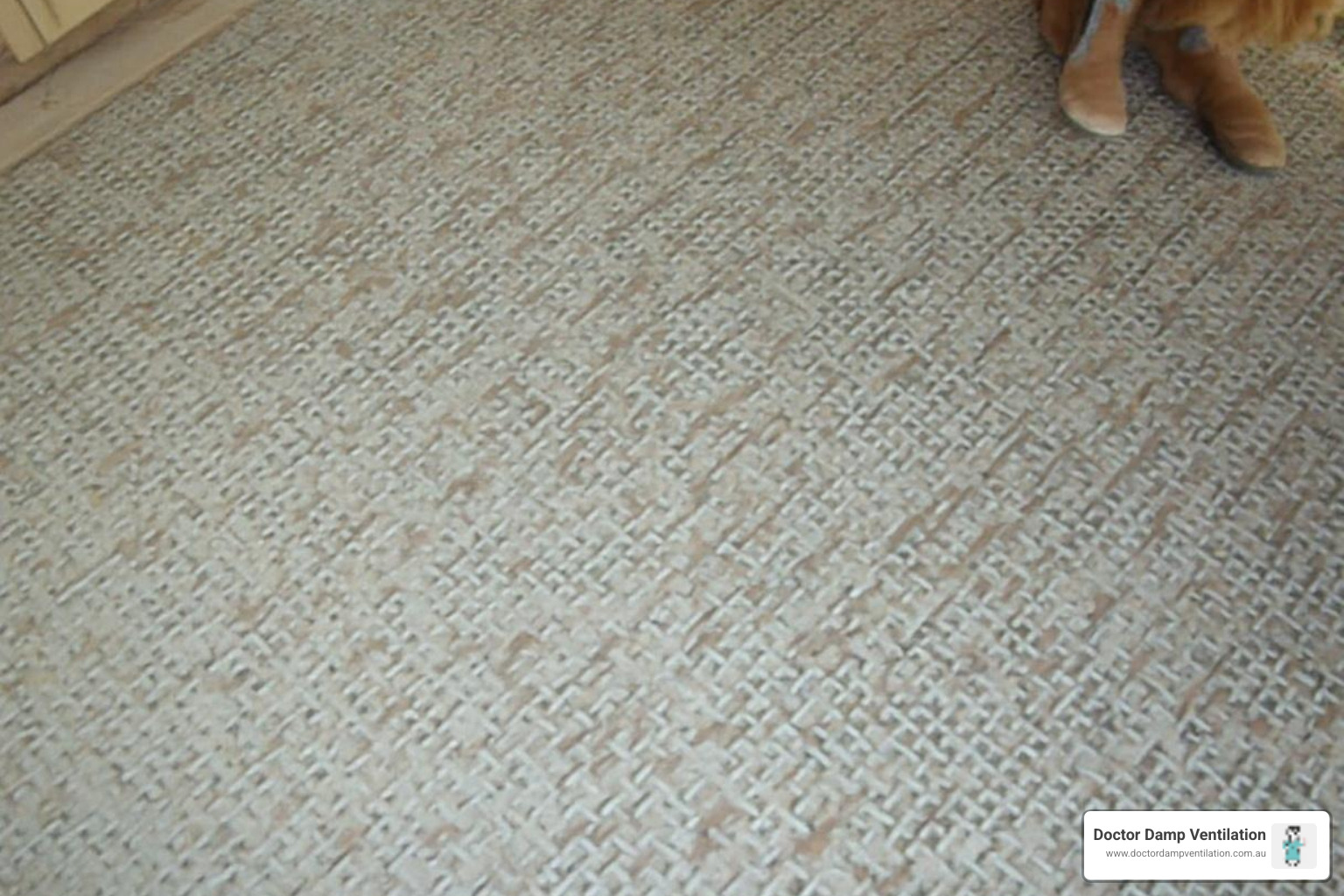
At its heart, subfloor ventilation is all about getting rid of unwanted moisture and keeping the air moving. It sets up a controlled airflow beneath your home. This process actively removes damp, stagnant air and brings in drier, fresh air from outside. It’s like giving your subfloor a refreshing breeze! This continuous air exchange is super important for preventing condensation, lowering humidity levels, and creating a consistently dry environment. By doing this, we effectively protect your home’s vital timber structures from the damaging effects of moisture, rot, and even those pesky pests.
The Science of Air Exchange
The basic idea is simple: air needs to flow. When it comes to your subfloor, we achieve this movement in two main ways: passive ventilation or mechanical ventilation.
Passive ventilation relies on nature’s own airflow. Think of strategically placed air bricks or vents in your home’s exterior walls. These are designed to encourage a cross-ventilation effect, where air enters one side and exits another, carrying any moisture right out with it. Sometimes, a “chimney effect” can also help, as warmer, moist air naturally rises and escapes through higher vents. Building guidelines, like those in the UK, often recommend specific sizes for these vents (for example, 1500mm² for every metre of your home’s perimeter) and placement rules (like keeping them at least 75mm above the damp proof course). These benchmarks help ensure air can circulate effectively.
However, in Sydney’s often humid climate, or for homes with tricky layouts (like some older terrace houses in Newtown or Glebe that have lots of internal walls or ground levels higher than the floor), passive systems often aren’t enough. They depend on wind and natural drafts, which aren’t always reliable.
That’s where mechanical ventilation systems really shine! These systems use powered fans to actively pull air out of your subfloor space. These fans create a slight negative air pressure, effectively “sucking” out all that damp, stale air. As this air is pushed out, fresh, dry air is naturally drawn in from outside. This constant “suck and blow” action ensures a steady, powerful air exchange. It’s much more effective than just waiting for the wind to blow! We often help homeowners in areas like Leichhardt and Balmain who find mechanical systems are the perfect answer to their subfloor dampness problems.
You can dive deeper into how building regulations influence ventilation by checking out the UK building regulations for ventilation.
Beyond Moisture: Tackling Radon and VOCs
While moisture is a big concern, it’s not the only hidden threat that can lurk in your subfloor. Your ventilated floor system also plays a super important role in protecting your home from harmful ground gases like radon gas and Volatile Organic Compounds (VOCs).
Radon gas is a naturally occurring, radioactive gas. It’s completely invisible and odourless, and it can seep up from the ground into your home. While less common as a major issue in Sydney compared to some other parts of the world, long-term exposure to radon is a known health risk, so it’s always best to be proactive.
Volatile Organic Compounds (VOCs) are another concern. These invisible gases are emitted from many common household items and building materials. Think new furniture, paints, cleaning supplies, and even some types of flooring. In poorly ventilated spaces, these compounds can build up, contributing to poor indoor air quality. This can lead to issues ranging from headaches and dizziness to more serious long-term health effects.
The good news is, a strong subfloor ventilation system works wonders here too! By continuously exchanging the air in your subfloor, it dilutes and removes both radon gas and VOCs before they ever have a chance to enter your living spaces. This significantly improves your overall indoor air quality. It’s a vital step in creating a truly healthy home environment for you and your loved ones. We believe every home should be a safe haven, and that’s why we focus on solutions that contribute to a Healthy Home.
The Crucial Role of a Ventilated Floor in Your Home’s Health
A ventilated floor isn’t just about preventing problems; it’s about actively promoting a healthier, more comfortable living environment. Think of it as investing in your home’s long-term health and your family’s well-being.
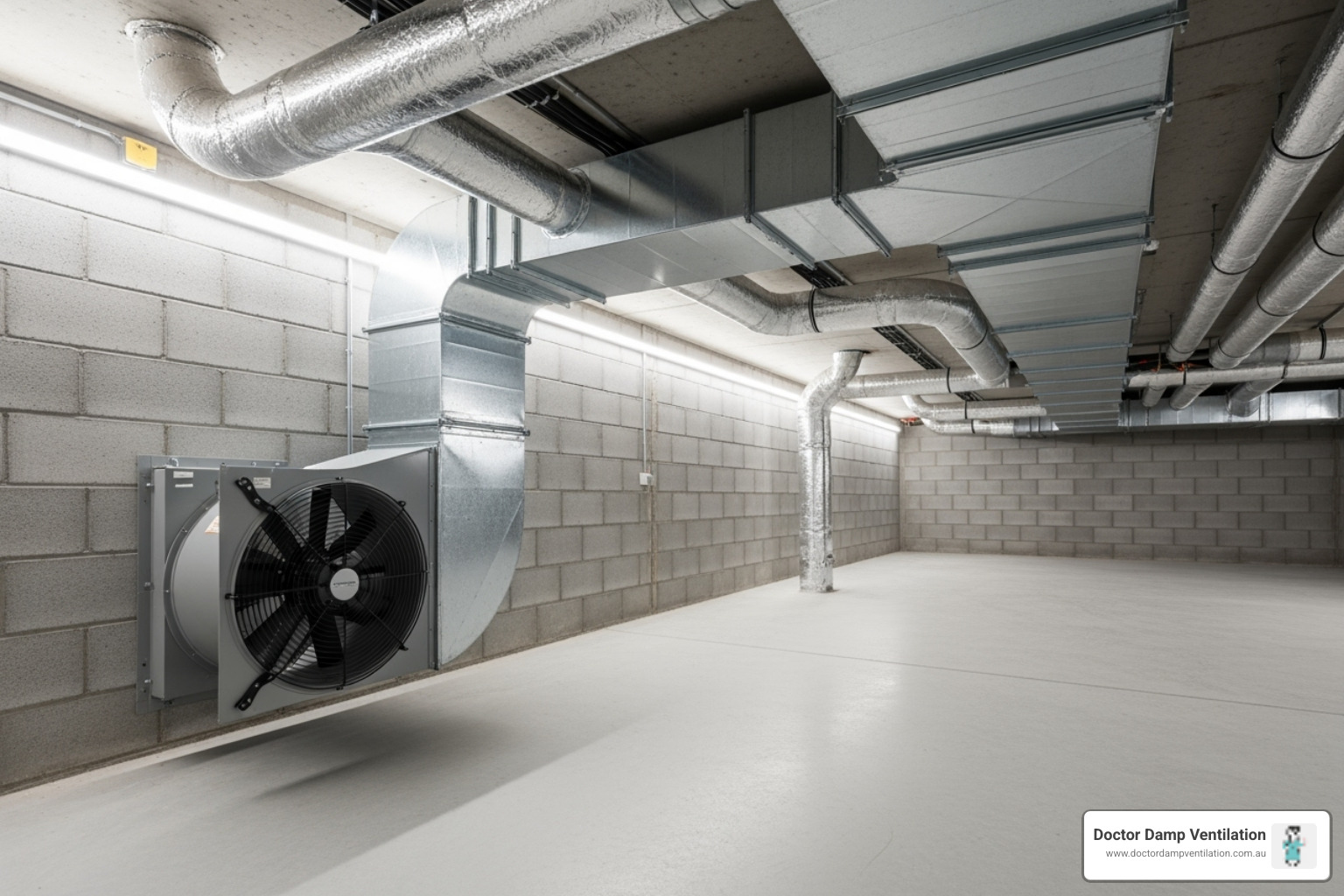
When we talk about a ventilated floor, we’re describing the complete system that ensures proper air exchange beneath your home. This includes essential parts like airbricks (or vents), smart ducting, and powerful fans. All these components work hand-in-hand to create the perfect conditions in your subfloor. For homes in Maroubra, Coogee, and across the Eastern Suburbs, where that coastal humidity can really be a challenge, picking the right solution is super important.
Passive vs. Mechanical: What’s Right for Your Ventilated Floor?
Choosing the best ventilation system for your home depends on a few things: how old your property is, how it’s built, and how bad your moisture issues are. We mainly look at two types of systems:
| Feature | Passive Ventilation System | Mechanical Ventilation System |
|---|---|---|
| How it Works | Uses natural air currents and wind through well-placed air bricks/vents. | Uses powered fans to actively pull out or push in air, creating forced airflow. |
| Effectiveness | Limited; really depends on outside weather (wind, temperature changes). Can struggle in calm weather or with tricky subfloor layouts. | Super effective; gives you consistent, controlled airflow no matter what the weather’s doing. Can even focus on specific damp spots. |
| Cost | Generally lower upfront cost for basic air brick installation. | Higher initial cost because of fans, ducting, and electrical work. |
| Maintenance | Needs regular cleaning of leaves and dirt from vents to keep them clear. | Needs less frequent maintenance (like checking fans) but systems can lose performance over time if not looked after. |
| Ideal Scenario | Homes with good natural airflow, simple subfloor spaces, and only minor damp problems. Often good for new homes designed with proper ventilation. | Homes already dealing with damp or mould, complex subfloor layouts, high humidity, or ground gases. Perfect for upgrading existing homes. |
Natural airflow through air bricks is a great start and often required by building rules. However, we’ve seen countless homes, especially in areas like Burwood and Strathfield, where just relying on passive vents simply isn’t enough to beat that stubborn dampness. Modern mechanical systems, with their powerful yet quiet fans, offer a much stronger solution. These can be set on a timer, perhaps running during the best drying hours (like 10 am to 4 pm), or even use sensors to automatically adjust fan speed based on moisture levels – saving you energy too!
Modern Solutions for a Ventilated Floor
The way we build homes has come a long way, bringing us some fantastic new ways to create a top-notch ventilated floor, especially handy for new houses or big renovations.
One cool innovation is the use of permanent formwork systems, like the clever Iglu’® system. Imagine modular, recycled plastic pieces laid out before the concrete is poured. This creates a permanent, raised space under your floor. This design doesn’t just give you built-in ventilation; it also acts as a barrier against rising humidity and helps safely get rid of gases like Radon. These systems can also cut down on the concrete and labour needed compared to old-school methods, offering a really strong and efficient solution for homes in places like Rhodes and Wentworth Point.
Another great leap forward is found in insulated base floors, like those using FINNFOAM products. These super-strong insulation panels are designed to create a ventilated base floor while giving you excellent thermal insulation. They stop moisture from coming up from the ground, boost your home’s energy efficiency (especially if you have underfloor heating!), and make construction simpler. This smart combo of ventilation and insulation ensures you have a dry, warm, and highly efficient ventilated floor.
These modern solutions bring a ton of benefits, including better energy efficiency because a dry floor holds heat better. They also create a clean, dry space for all your pipes and wires, making future maintenance a breeze. Adding these solutions to your home’s design, perhaps even alongside air purification systems for your air conditioners, can truly transform your indoor environment. Curious? Learn more about Air Purification for Air Conditioners.
Installation and Maintenance Best Practices
Getting your ventilated floor system properly installed is like giving your home a health check-up – it’s something you want done right the first time. The difference between a system that works brilliantly and one that disappoints often comes down to proper installation and ongoing care.
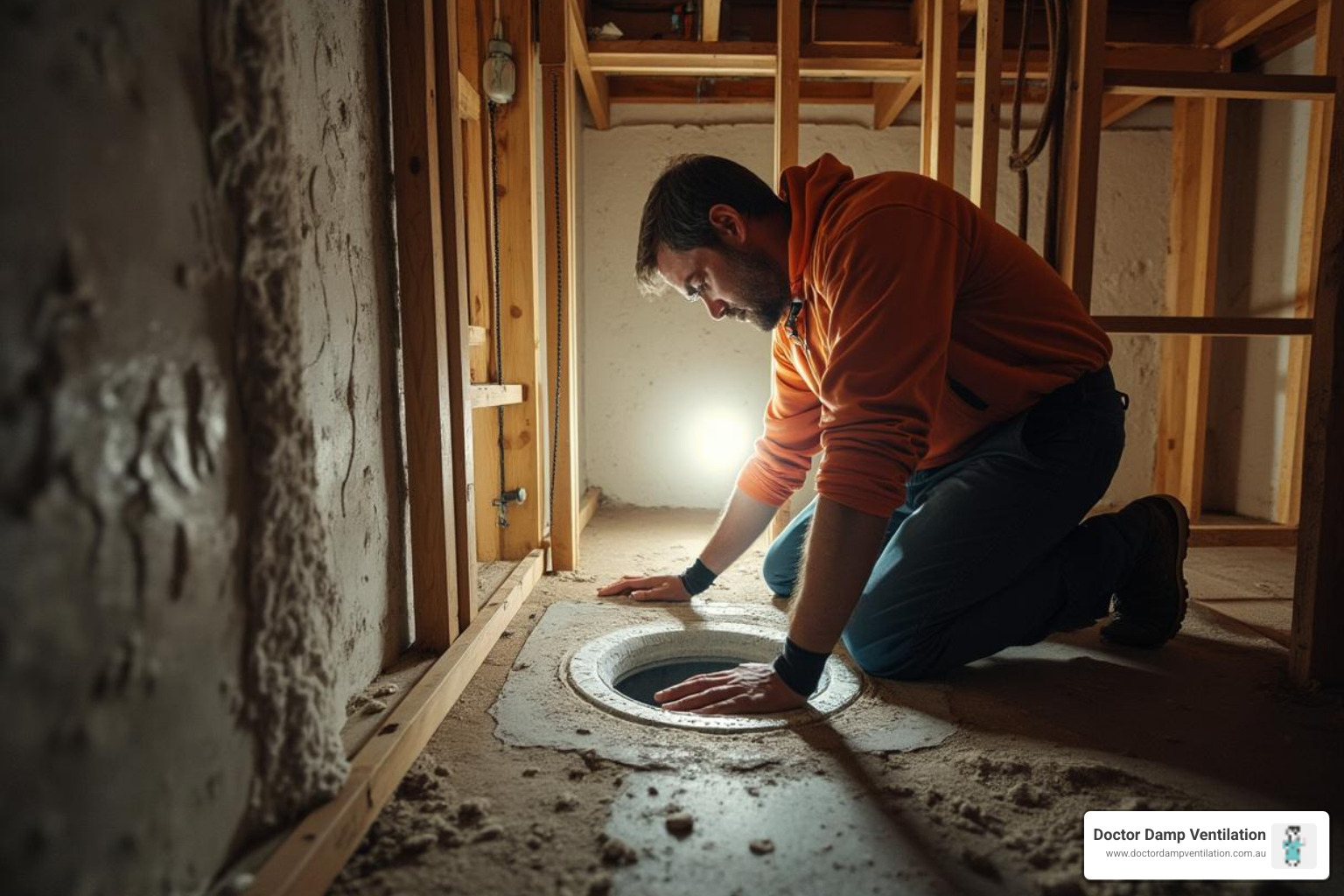
Whether you’re dealing with an existing home that needs help or planning a new build, following best practices ensures your investment pays off for years to come. While you can certainly do some basic checks yourself, getting a professional assessment is crucial for diagnosing the real issues and designing an effective solution.
The truth is, every home is different. What works perfectly in a modern home in Maroubra might need a completely different approach in a heritage terrace in Paddington. That’s why understanding your specific situation is so important.
Retrofitting Ventilation in Existing Sydney Homes
Older Sydney homes have character – and challenges. If you’re living in one of those beautiful Victorian terraces in Paddington or a charming inter-war home in Ashfield, you’ll know exactly what we mean. These homes weren’t built with modern ventilation standards in mind, and decades of modifications can create some interesting puzzles to solve.
Blocked vents are probably the most common issue we encounter. Over the years, landscaping changes, higher ground levels from garden beds, overgrown vegetation, or even concrete paths can completely seal off original air bricks. We’ve seen homes in Darlinghurst and Redfern where the original vents are buried under decades of “improvements.”
Extensions are another culprit. When families expand their homes, the new additions sometimes inadvertently block crucial airflow paths. It’s not anyone’s fault – it’s just that subfloor ventilation wasn’t always top of mind during renovations.
Limited access presents its own set of challenges, especially in the split-level designs you’ll find throughout Surry Hills. Some sections of these subfloors end up completely enclosed by concrete floors or party walls, making traditional vent installation nearly impossible.
Then there are the complex subfloor layouts common in older homes. Internal brick sleeper walls and partitions can create isolated pockets where air simply can’t flow properly, turning parts of your subfloor into stagnant moisture traps.
But here’s the good news: every problem has a solution. In those narrow Paddington terraces with limited external access, we can run internal ducting systems through floors or even use old chimney flues to create a vacuum effect that draws damp air out. Sometimes, strategic excavation outside to create space for new vents becomes the best approach.
The key is getting a thorough professional assessment. We need to understand what’s causing your specific dampness issues and design a custom solution that works with your home’s unique layout. Professional installation ensures everything is correctly sized, positioned, and meets all the necessary standards – because getting it right the first time saves you money and headaches down the track.
Maintaining Your Ventilation System for Longevity
Once your ventilated floor system is up and running, keeping it in top shape doesn’t require much effort – just a little regular attention. Think of it like maintaining your car: small, regular checks prevent big, expensive problems later.
Keeping vents clear is probably the most important thing you can do. Take a walk around your home every few months and check that external air bricks and vent openings aren’t blocked by leaves, dirt, or that enthusiastic garden that’s grown a bit too close. A clear path for air is essential for the whole system to work properly.
While you’re checking the vents, make sure any grilles are intact and undamaged. These aren’t just for show – they prevent unwanted visitors like rodents or possums from setting up house in your subfloor. Nobody wants that surprise!
If your system uses internal ducting, inspect any accessible sections occasionally for signs of damage or collapse. Most of the time everything will be fine, but it’s worth a quick look when you’re doing other maintenance around the house.
For mechanical systems, listen for your fans from time to time. Modern fans are incredibly quiet, but if you notice a change in sound or complete silence when they should be running, it might indicate an issue that’s easily fixed if caught early.
We recommend annual professional check-ups for your system. Our technicians can assess overall performance, spot potential issues before they become major problems, and ensure your system continues providing optimal air exchange. It’s a small investment that protects your much larger investment in your home.
By following these simple practices, your ventilated floor will continue protecting your property and keeping your family healthy, delivering fresh, clean air without any fuss. After all, the best systems are the ones you don’t have to think about – they just quietly do their job, year after year.
Conclusion
We’ve dug deep into the world beneath your floors, uncovering the critical role a ventilated floor plays in creating a healthy, comfortable, and structurally sound home. We’ve seen how pervasive moisture can lead to a cascade of problems, from musty odours and mould to structural rot and exacerbated health issues for your loved ones. More importantly, we’ve explored how a well-designed subfloor ventilation system actively combats these hidden threats, ensuring your home breathes easy.
Recapping the immense benefits, a properly ventilated floor system offers a triple win for you and your property. Firstly, it protects your property value by preventing timber rot, structural damage, and unwelcome pest infestations. Think of it as a long-term guardian for your biggest asset. Secondly, it safeguards your family’s health in a profound way. By eliminating mould, reducing harmful gases like radon and VOCs, and generally improving indoor air quality, you’re looking at fewer allergies, asthma symptoms, and respiratory problems. And finally, it simply ensures comfort. Say goodbye to those persistent musty smells, the clammy feel of excessive humidity, and the general discomfort that comes with a damp living environment. Your home should be your sanctuary, not a source of worry!
This isn’t just a quick fix; it’s a smart, long-term solution that addresses the very root cause of many common household woes. While the concept of a ventilated floor might seem a bit technical, the positive impact on your daily life and peace of mind is truly profound.
For homeowners across Sydney, from the busy inner-west suburbs like Glebe and Leichhardt to the more expansive areas of Penrith and Campbelltown, understanding and addressing subfloor ventilation is absolutely crucial. Given the complexities of different home constructions and the unique moisture challenges we face here, the importance of a professional assessment cannot be overstated. It’s about getting the right solution for your home.
At Doctor Damp Ventilation, we’re specialists in mould removal, damp solutions, and, of course, expert sub-floor ventilation systems for homes. Our core mission is simple: improving your indoor air quality and protecting your property value. We pride ourselves on offering expert, non-toxic, and guaranteed mould and damp remediation services. We don’t believe in one-size-fits-all; we provide custom solutions, ensuring your home gets exactly what it needs to breathe freely and stay healthy.
Don’t let hidden damp issues hold your breath any longer. Take the first, easy step towards a healthier, happier home by reaching out to the experts who care.
Contact us for a sub-floor ventilation assessment today.

